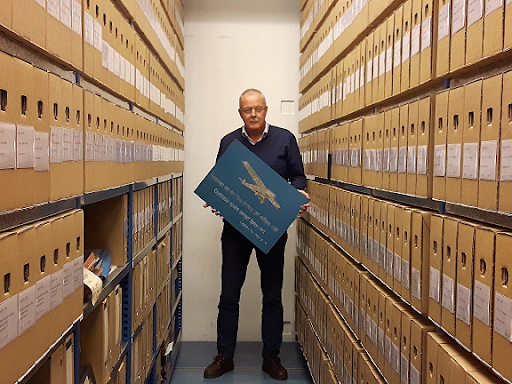What do we see?
We see a somewhat faded blue plate of about 64 x 44 cm. In the center a representation of an airplane with the registration letters HN-ACC. Underneath it a Latin text: "Bataviam van der Hoop primus per aethera volat. Gymnasio nostro semper honori erit. d. XXIV m. Nov. MCMXXIV". In the background, a number of red dots can just be seen, originally connected by a thin line and bearing place names.
From the HDC collection | Protestant Heritage
This is a plaque that belonged to the archive of the Association for Preparatory University Education on Reformed Foundations in Amsterdam (1889-1972), which was added to the HDC | Protestant Heritage collection in 1984. That association operated a gymnasium that was known as the "Gereformeerd Gymnasium" or "Het Woltjer Gymnasium. That name referred to one of the initiators and driving force behind the school on Keizersgracht, the VU professor Jan Woltjer.
Plaque honors Jan van der Hoop
I chose the plaque for no other reason than that I like airplanes and that there is little about aviation to be found in our collection - about 2.5 kilometers of archives. The plaque honors Jan van der Hoop, who passed his final exams at the Woltjer in 1912, and who flew to Batavia together with Hendrik van Weerden Poelman and engineer Pieter van den Broeke.
By plane to India
Abraham Nicolaas Jan Thomassen à Thuessink van der Hoop, as his full name was, was the son of the antirevolutionary politician G.H. Thomassen à Thuessink van der Hoop and jkvr. Sara Maria Johanna van de Poll. Jan was born in 1893 and his father died within a year of his birth. His mother remarried the VU professor Prof. D.P.D. Fabius. After grammar school he went to study law at the VU. He did not finish that study and during the mobilsation of '14-'18 he became a second lieutenant pilot at the Aviation Department Soesterberg via the infantry. In 1922 he transferred to KLM and soon became one of the initiators of a flight to India. In 1924 the time had come and together with the aforementioned crew members they departed from Schiphol on October 1, 1924 in a Fokker F VII with registration HN-ACC.
Over Bulgaria the radiator broke and during the emergency landing the right undercarriage broke. A new engine had to be brought from the Netherlands, and 4 Fokker technicians made the plane airworthy again on the spot, so that the journey could be continued on November 2. On November 24, Batavia was reached, after a distance of 15,373 km, in just over 127 hours spread over 20 flying days, at an average speed of over 120 kilometers per hour. The enthusiasm in the Dutch East Indies but also in the Netherlands was overwhelming, the newspapers - including De Standaard, which devoted two columns to it on the 24th of November - reported enthusiastically about it.
Van de Hoop then went on to study geography in Utrecht, obtained his doctorate in 1932 and continued to spend his working life in the Dutch East Indies. He died in 1969 at the age of 75.
